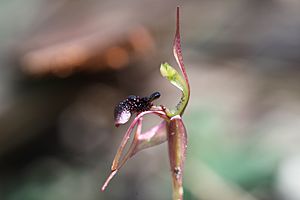Common ant orchid facts for kids
Quick facts for kids Common ant orchid |
|
|---|---|
 |
|
| Scientific classification | |
| Synonyms | |
|
The Chiloglottis formicifera, often called the common ant orchid, is a special type of orchid. It grows only in New South Wales, Australia. This orchid has two wide leaves. It also has a single, narrow flower that can be greenish or reddish. A unique part of the flower, called the labellum, has a black, ant-like shape on it. This is why it's called the ant orchid! There is one old record of this plant being found in New Zealand.
Contents
What Does the Common Ant Orchid Look Like?
The common ant orchid is a plant that grows from the ground. It is a perennial plant, meaning it lives for more than two years. It is also deciduous, so its leaves fall off at certain times. This plant has two leaves that are about 30 to 60 millimeters (1.2 to 2.4 inches) long. They are also about 15 to 25 millimeters (0.6 to 1 inch) wide.
A single flower grows on a stem that is 60 to 100 millimeters (2.4 to 3.9 inches) tall. The flower itself is about 12 to 16 millimeters (0.5 to 0.6 inches) long. It is also about 6 to 8 millimeters (0.2 to 0.3 inches) wide. The flower can be greenish or reddish in color.
Parts of the Ant Orchid Flower
The top part of the flower, called the dorsal sepal, is shaped like a spatula. It is about 10 to 12.5 millimeters (0.4 to 0.5 inches) long. The two side sepals are about 9 to 10 millimeters (0.35 to 0.39 inches) long. They stand up at the bottom and then curve downwards. All three sepals have a tiny, sticky tip.
The petals are shaped like a spear, wider at the top and narrower at the bottom. They are about 8 to 10 millimeters (0.3 to 0.4 inches) long. These petals turn strongly downwards. The labellum is a diamond shape. It is 7 to 10 millimeters (0.3 to 0.4 inches) long. Most of its top surface is covered by a shiny, black, ant-like shape. This part is called a callus. The common ant orchid usually flowers from August to November.
How the Common Ant Orchid Got Its Name
The common ant orchid was first officially described in 1877. A botanist named Robert D. FitzGerald wrote about it. He published his description in his book called Australian Orchids. The plant he described was found in a valley near Kurrajong.
The scientific name for this orchid is Chiloglottis formicifera. The second part of the name, formicifera, comes from two Latin words. Formica means "ant". The ending -fera means "to bear," "to carry," or "to have." So, the name formicifera means "ant-bearing" or "having ants," which makes sense because of its ant-like feature!
Where Does the Common Ant Orchid Live?
The common ant orchid likes to grow in damp places. You can find it in forests in New South Wales. It grows in areas between the Northern Tablelands and Nowra. There is also one old record of this orchid being found far away in Kaitaia, New Zealand.

